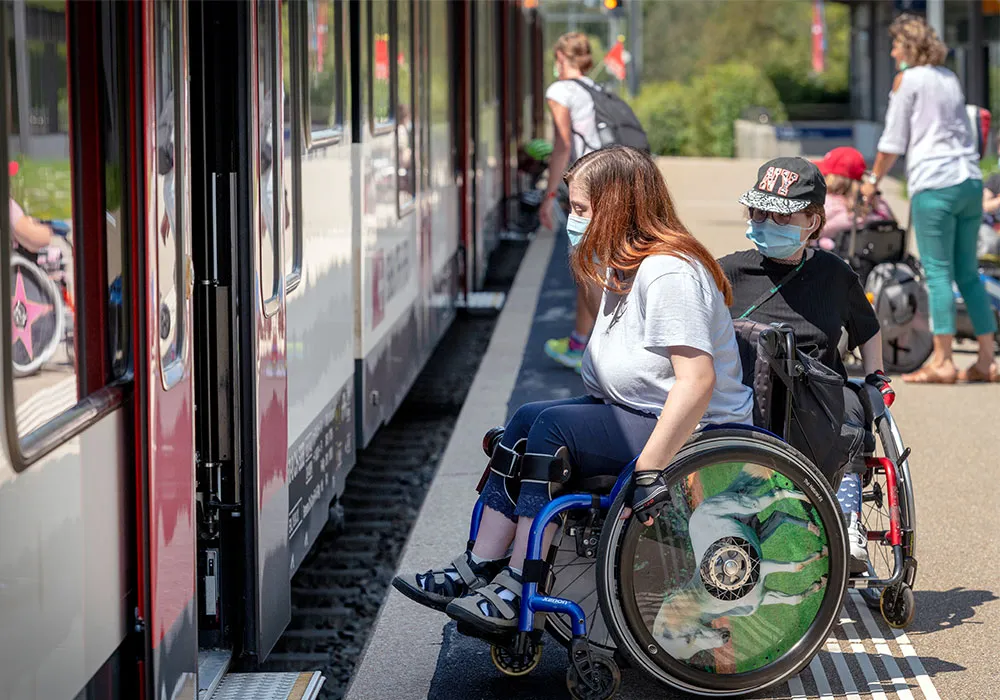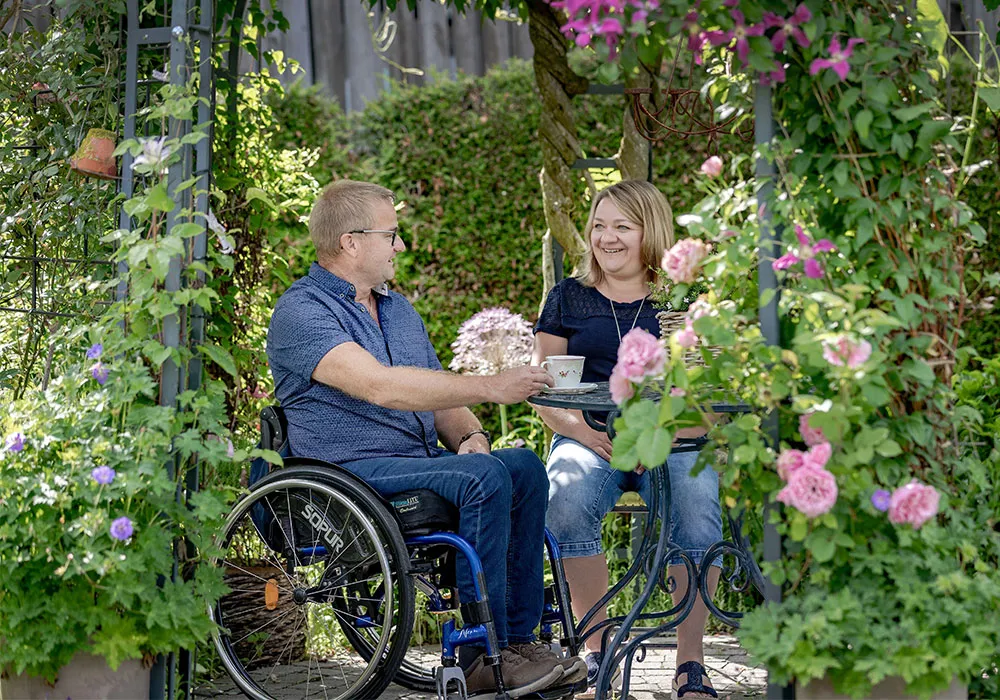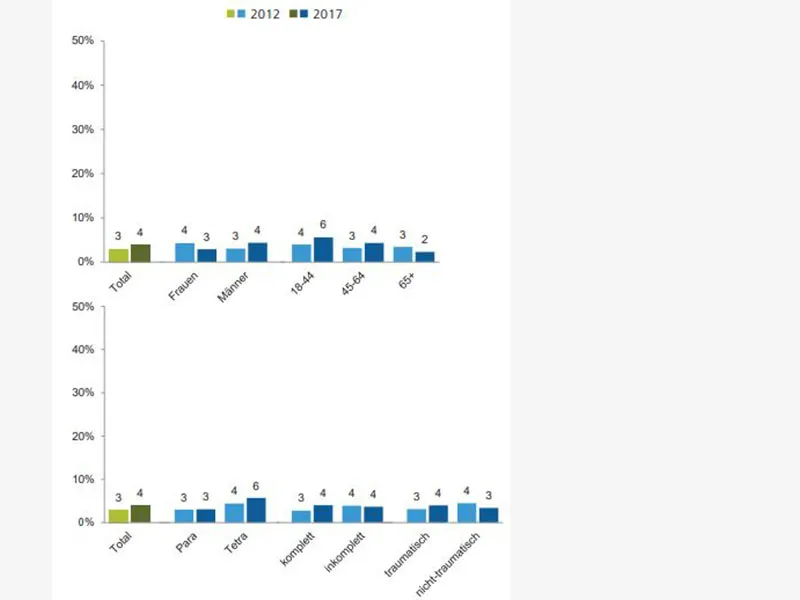
Tips for encounters with wheelchair users
People with a spinal cord injury are part of our society. Studies have shown that only a small minority of people with a spinal cord injury feel rejected by the general population. Personal contact between able-bodied people and people with a spinal cord injury often plays a decisive role here. It helps to break down prejudices. What needs to be taken into account in the case of direct contact with people with a spinal cord injury? We have useful tips for you on ideal interactions with wheelchair users.
Hannes* and Lukas* have tetraplegia. They are dependent on a wheelchair in their day-to-day life. Most of the general population are unaware of everything this entails. “Although many people think that my greatest problem is no longer being able to stand up, this isn't the case at all”, says Hannes. “The fact that my bladder and bowel function and my circulation have been impaired by the spinal cord injury are much greater challenges for me.”
Hannes and Lukas have experienced being treated differently to how they would have liked by able-bodied people. In order to help you better understand the topic of spinal cord injuries, we have put together five tips for you about how to interact with people with a spinal cord injury.
* names have been changed
“Although many people think that my greatest problem is no longer being able to stand up, this isn't the case at all.”
How to interact with people with a spinal cord injury
Treat people with a spinal cord injury in the same way you like to be treated
Wheelchair users are no different to you and me. We all appreciate being treated in a respectful and friendly way.
People with a spinal cord injury will tell you if they need help
When you offer to help a person with a spinal cord injury, always first ask how you can help. The person will let you know whether they would like help and what kind of support they need. Lukas can confirm this: “I personally like it if people want to help me. However, if wheelchair users are actively out and about on their own, they will ask if they need help. If I don’t need help, you need to simply accept that.”

File image: A wheelchair user is getting onto a train. If they need help, they will ask for it of their own accord.
Observe distance zones
Aids are something extremely personal for people with a spinal cord injury, which makes them taboo for others. As is the case for you, people with a spinal cord injury do not particularly like being touched without permission. Hannes adds: “Personally, I don't like it if somebody pushes me around without asking. If the person pushes down on my shoulder, I may tip forwards because of my lack of torso stability.”
Speak to people with a spinal cord injury and not about them
Wheelchair users appreciate being addressed directly and not being spoken about with whoever is accompanying them. Direct eye contact goes without saying here. Do not speak about the wheelchair user in the third person. Lukas experienced this out on a walk with his wife and dog. “I had my dog on the lead when we started talking to another woman who was also out walking. She asked something about our dog and looked at my wife the whole time. Although I answered, she kept addressing my wife and expected her to be the one to reply.”

Do not look at wheelchair users as different people
People with a spinal cord injury usually still have the same personalities with the same strengths and weaknesses that they had before their accident or illness – they just happen to be sitting down now. “Many people automatically assume that I’m not doing well and feel sorry for me”, says Lukas. “But I’m actually just a completely normal guy.” Hannes is of exactly the same opinion: “After my accident I told the people around me: treat me as the same person I was before. It was really good for me that they all respected this.”
“Many people automatically assume that I’m not doing well and feel sorry for me. But I’m actually just a completely normal guy.”
Contact as a necessity
There can be numerous causes for poor interactions with people with a spinal cord injury. An extremely important factor is the perception of spinal cord injuries in society. In order to guarantee equal opportunities for wheelchair users, potential prejudices need to be recognised. Studies have shown that people with a spinal cord injury have to deal with prejudices compared to able-bodied people, with attributes such as intelligence or diligence being assessed more negatively.
As sobering as this result is, studies have also identified starting points for breaking down prejudices. Personal contact with people with a spinal cord injury results in these people being perceived primarily as people and not as “disabled”. In this way, negative attitudes and uncertainties are broken down. Lukas has also experienced this: “When I speak openly to people and they recognise that I am confident in who I am, this leads to completely normal and pleasant conversations. To achieve this, however, I need to take the first step.” This means that contact between people with a spinal cord injury and able-bodied people is essential for the integration of the former into society.
Hannes has noticed that people with a spinal cord injury are perceived by society. “The integration and inclusion of people with a spinal cord injury has definitely improved compared to in the past. Today, for example, it is completely normal for a wheelchair user to go shopping.” However, do other people with a spinal cord injury see this in the same way? The diagram on the left provides an answer to this question. It shows the percentage of people with a spinal cord injury whose life is made significantly more difficult due to negative attitudes in society (stratified according to sex, age and definition of the spinal cord injury). The percentage of people with a spinal cord injury who have problems with negative social attitudes is extremely low at about three to four per cent and remained almost unchanged between 2012 and 2017.

This might also be of interest
Every other day somebody in Switzerland sustains a spinal cord injury.
Spinal cord injuries result in high follow-up costs, e.g. for home and car modifications. This is why you should become a member of the Benefactors' Association of the Swiss Paraplegic Foundation so that you receive CHF 250,000.00 should the unthinkable happen.
Become a member now
Subscribe to the newsletter
I would like to take an exclusive look behind the scenes of the Swiss Paraplegic Foundation.
Werden Sie jetzt Mitglied und erhalten Sie im Ernstfall 250 000 Franken.

